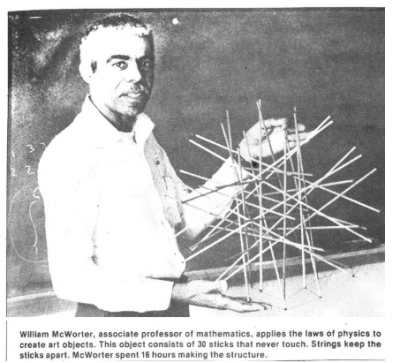Nearly 200 mathematicians who identify as Black have earned mathematics degrees at Ohio State. These mathematicians have gone on to become prolific researchers, authors, high school teachers, economists, department chairs, lawyers, Ohio State personnel and university presidents. Many of these mathematicians remain “hidden” in the sense that their accomplishments — individually and collectively — are underrepresented in the public awareness. Among the mathematics degrees at Ohio State earned from this group, seven were PhD degrees from 1963 to 1984 and 20 were master’s degrees from 1963 to 1998. The project “Hidden Figures Revealed: Dynamics Narratives and History of Black Mathematicians at the Ohio State University” seeks to address the interplay in this underrepresentation at the levels of public awareness and graduate programs.
The project, recently awarded a Seed Fund for Racial Justice from Ohio State, more broadly aims to inspire institutional, regional and national reform in both the representation and educational experience of Black Americans in mathematics and the larger natural sciences. Researchers involved include five faculty and staff across the university, with own Ranthony Edmonds as the grant PI, partnering with the National Afro-American Museum, the Cultural Center/Ohio History Connection and the National Math Alliance. This summer the project team also included three undergraduate students--Jordan Carter (communications) and Doria Lee (math) from Central State University, a historically black college in Wilberforce, Ohio, and Katherine Lovelace (math and african american and african studies) from Ohio State.
The project consists of two core components. One component contextualizes the dearth of Black Americans in math. What is the historical role of large public research universities in the development of Black talent in the mathematical sciences? What historical and contemporary factors have contributed to the dearth of those who identify as Black in the mathematical sciences? The second component explores solutions to this underrepresentation. For example, how can art, strategic communication and/or storytelling be leveraged to increase representation and public awareness of Black Americans in the mathematical sciences?
This summer the research team gathered background information on Black math alumni from Ohio State during three specific periods: 1963 to 1984, 1985 to 1998, and 1999 to present. The alumni were grouped according to highest degree earned from Ohio State. There are approximately 30 alumni who have earned graduate degrees (masters or doctorate) since 1963, and archival research was conducted to understand their personal histories and mathematical careers. In addition, the team focused on contextualizing major departmental, campus, and regional events that would impact the educational experiences of these individuals.
Dr. William McWorter, Jr.

Dr. William McWorter, Jr. is the first mathematician of African descent to earn a doctoral degree in mathematics from Ohio State. A native of Cleveland, Ohio, Dr. McWorter spent the majority of his educational and professional career in the math department at Ohio State. He earned a bachelor’s degree in 1958, a master’s in 1959, and a PhD in 1963, all from the math department at Ohio State.
After earning his PhD, Dr. McWorter went on to work as an assistant professor at the University of British Columbia and then returned to Ohio State where he retired as an Associate Professor in mathematics in 1993. During his tenure at Ohio State Dr. McWorter published 16 research articles. In addition to his work in geometric group theory, he was a pioneer in fractal theory, and there are several fractals, such as the McWorter Dendrite and the McWorter pentigree named after him.
Dr. McWorter was also interested in computational linear algebra. He collaborated with Dr. Alan Nering in the math department to teach the honors linear algebra course (now 2568h) and shared a zeal for determinant-free techniques for student computations of eigenvalues and characteristic polynomials. One goal of the Hidden Figures project is to produce a lesson plan for linear algebra based on two papers written by Dr. McWorter in this topic.
A Singular Period (1963-1984)
These 21 years, when all seven PhD degrees and five of the master’s degrees were granted, saw a number of salient events locally and nationally. The Black Student Movement, an advocacy group for Black Americans on American campuses, was founded (1967). School desegregation followed Brown v. Board of Education (1954). In support of the space race (1955-1975), government support for science, technology, engineering and mathematics (STEM) initiatives shot up. For example, the National Science Foundation (NSF) started creating fellowships for graduate study in mathematics as well as for summer programs. At the university, the Office of Diversity and Inclusion (ODI) was created (1970).
At the math department, Arnold Ross who chaired the department 1963-1976 was recognized among those seven PhD graduates as a strong advocate for minorities in math. He had a direct role in recruiting Rada Higgins to his Ross Mathematics Program. Higgins would go on to become the 20th Black woman in the world to earn a PhD in mathematics, which she obtained from Ohio State in 1974. Hans Zassenhaus arrived at Ohio State (1963) and supported young and gifted students in the Ross Program and may have personally advocated for William McWorter Jr. to join as associate professor in the department.

Other Periods
Between 1985 and 1998, approximately fifteen master’s degrees were granted. The period between 1999 and 2021 saw just four master’s degrees granted, with no PhD degrees since 1984. What historical trends reflect or influence these trends? For example, Ohio State switched from rolling admissions to selective admissions in 1988; how did the switch affect Black enrollment in the larger university and within the math major? Many early PhDs were funded by the NSF during and after the space race; were these funding sources replaced? What are some of the accomplishments of the degree earners from these time periods? The project will attempt to fill in the gaps and paint a richer picture of the sociopolitical milieu in which Black students found themselves.

Call for Volunteers
To that end, the project is calling on all former mathematics undergraduate and graduate students from Ohio State to help provide stories and answers to questions regarding the environment for Black Americans in the math department at OSU in any and all of these time periods. Interested alumni are encouraged to contact BlackMathStory@osu.edu, in order to share relevant personal stories and anecdotes and to be contacted at a future point about filling out some surveys and answering follow-up questions.
